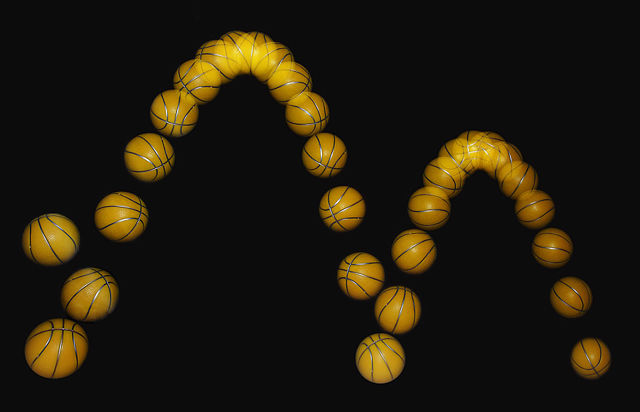Image:Bouncing ball strobe edit.jpg
From Wikipedia, the free encyclopedia

Size of this preview: 640 × 412 pixels
Full resolution (1,800 × 1,159 pixels, file size: 293 KB, MIME type: image/jpeg)
| |
This image was selected as picture of the day on the English Wikipedia for February 22, 2008. |
File history
Click on a date/time to view the file as it appeared at that time.
| Date/Time | Dimensions | User | Comment | |
|---|---|---|---|---|
| current | 17:27, 8 October 2007 | 1,800×1,159 (293 KB) | Richard Bartz | ({{Information |Description=A bouncing ball captured with a stroboscopic flash at 25 images per second. Note that the ball becomes significantly non-spherical after each bounce, especially after the first. That, along with spin and air-resistance, causes ) |
File links
The following pages on Schools Wikipedia link to this image (list may be incomplete):
Metadata
This file contains additional information, probably added from the digital camera or scanner used to create or digitize it. If the file has been modified from its original state, some details may not fully reflect the modified file.
| Camera manufacturer | Canon |
|---|---|
| Camera model | Canon EOS 20D |
| Exposure time | 8/5 sec (1.6) |
| F-number | f/4.5 |
| Date and time of data generation | 18:25, 29 September 2007 |
| Lens focal length | 18 mm |
| Orientation | Normal |
| Horizontal resolution | 350 dpi |
| Vertical resolution | 350 dpi |
| Software used | Adobe Photoshop CS Windows |
| File change date and time | 19:25, 8 October 2007 |
| Exposure Program | Manual |
| ISO speed rating | 200 |
| Exif version | 2.21 |
| Date and time of digitizing | 18:25, 29 September 2007 |
| Aperture | 4.33984375 |
| Exposure bias | 0 |
| Flash | 9 |
| Colour space | sRGB |
| Focal plane X resolution | 2886.36363636 |
| Focal plane Y resolution | 2885.80576307 |
| Focal plane resolution unit | inches |
| Custom image processing | Normal process |
| Exposure mode | Manual exposure |
| White balance | Auto white balance |
| Scene capture type | Standard |
Categories: Wikipedia featured pictures
